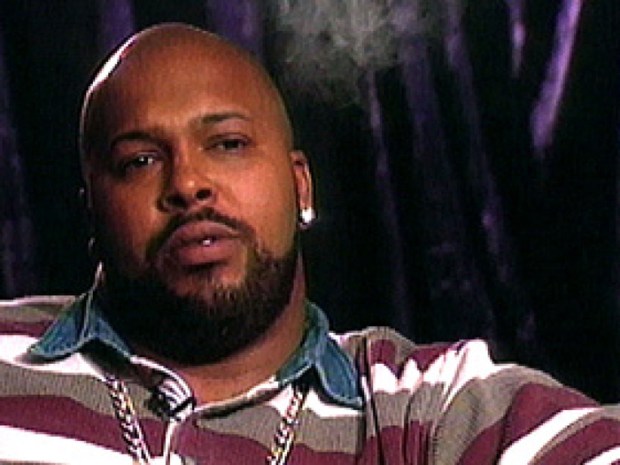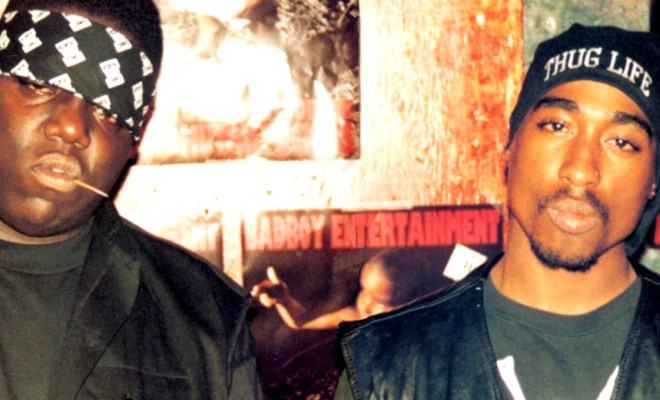Arguably one of the most vital events in the evolution of Hip Hop music, was the murders of Tupac Shakur and Biggie Smalls. They embodied the entirety of the famous “East Coast/West Coast Rivalry” that defined the Hip Hop genre in the mid-1990s, and were some of its most visible victims.
A detailed description of the rivalry would require much more text than is required here, but in theory, much of it centers on the two competing record labels, the artists they sign with and the individuals who operate them. Death Row Records, based in Los Angeles, is headed by Marion (Suge) Knight who disputes the “strong arm” tactic when negotiating a deal. Sean (later known as Puffy or Puff Daddy) Combs, founded Bad Boy Records in New York City and found quick success with Long Island rappers Craig Mack and Notorious BIG (Biggie Smalls) from Bedford-Stuyvesant, Brooklyn. The unofficial reason for the rivalry was the concept that East Coast artists looked down on West Coast artists, partly because of New York City’s reputation as “The Birthplace of Hip Hop.
The rivalry added to the strain as a personal conflict developed between Tupac Shakur and Biggie Smalls (born Christopher Wallace). Tupac believes that Biggie and Puffy were involved in a shooting and robbery at Quad Studios in Manhattan in which he suffered a gunshot wound (which both deny), and publicly accuses them of doing so. He also later admitted to having slept with Biggie’s wife, Faith Evans (a claim he denied), suggesting that doing so was a form of revenge for the shooting. There was also a series of “diss tracks” released between the two rappers.

Tupac was Suge Knight’s most prized artist, and for him the strain between Shakur and Smalls represented a personal opportunity to enhance Death Row Records’ reputation in the Hip Hop Market. To that end, he made a really public statement against Bad Boy Records which added fuel to the fire.
On September 7, 1996, Tupac was involved in a shooting in Las Vegas and died six days later on September 13. Initially, it was believed that the shooter was a widely known gang member, Orlando Anderson of Southside Compton Crips, but after one interview, Las Vegas police released him. Los Angeles Timesinvestigations reported, Chuck Philips, who also believed in Anderson’s role in the murder, also claimed Biggie Smalls’ involvement.
Six months later, on March 9, 1997, Biggie Smalls was killed in a shooting in Los Angeles shortly before the release of his second album, Life After Death.
At the time of Biggie’s death, Suge Knight was serving jail time for his role in the attack on Orlando Anderson, in which Tupac Shakur was also allegedly involved (one of the reasons why Anderson was the initial suspect in Shakur’s murder). Despite being in jail, Knight continued to run Death Row Records from a payphone.
Knight, like Tupac, believes, not only in Biggie’s involvement in the Quad Studio shootings, but was also part of Tupac’s entourage at the time of his murder, a fault which Biggie also pins on him. Knight has been an unofficial suspect in Biggie’s murder since then, but has never been arrested or charged. Despite the sentence he was serving on the night of the murder, Suge Knight is no stranger to the jail walls, but he has never seen it as the result of anything that directly connected him to the Biggie Smalls murder.
As recently as this past fall, several news outlets reported that, actor Tom Sizemore, who had met Suge Knight at an AA meeting testified that Suge Knight ordered the killings of Tupac and Biggie, a claim similar to the widely held theory that Knight have Shakur. killed because he tried to get out of his contract with Death Row, and then killed Biggie to create a distraction. While Knight’s involvement in Tupac’s murder is somewhat disputed, his role in Biggie’s death would be less so, at least according to one of the cops who investigated both incidents.
Slate Magazine, which has been running a podcast series titled Slow Burn since late last year, hosted by Joel Anderson, in which LAPD officer Greg Kading’s investigation into both cases appears to shed some new light on them.
With regards to Tupac, Kading’s findings implicate Orlando Anderson as the assailant. While this is beneficial information, Anderson can’t be charged with a crime because he was killed in a gang-related shooting in 1998.
What was significant in Kading’s investigation, however, was the revelation that there was reason to believe Knight’s girlfriend, had taken a kit order at Biggie Smalls. To verify this, he created a fake affidavit that looked like a sworn statement from a Knights directive, which Kading showed to his girlfriend (she used a fake name for him). After viewing this document, he then gave specific details of Suge Knight’s order to kill Biggie Smalls. At this point, it seemed that his role was more than suspicion and theory.
According to Kading, his girlfriend is now deceased and (like Orlando Anderson) can’t be prosecuted for a crime. Suge Knight, however, is still alive. Can he face charges in the Biggie Smalls murder, or will it remain an unsolved crime eternally? That may be a question for the ages.











